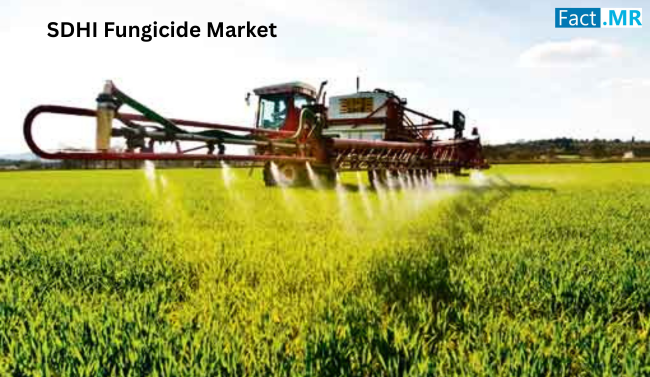As the global population continues to rise and food security becomes a top priority, the agriculture industry is under mounting pressure to improve crop yields while minimizing environmental impact. One of the most important tools aiding this transition is the SDHI (Succinate Dehydrogenase Inhibitor) fungicide. Known for their broad-spectrum control, long-lasting disease suppression, and compatibility with sustainable farming practices, SDHI fungicides are becoming essential in modern agriculture.
Market Overview and Future Outlook
The global SDHI fungicides market is on a strong growth trajectory. With an estimated value of over USD 3 billion in recent years, the market is projected to double by the end of the next decade, achieving a robust compound annual growth rate (CAGR). This expansion is driven by increased disease pressure, evolving farming practices, and technological advancements in agrochemical formulations.
The continued integration of SDHI fungicides in crop management programs is reinforcing their role in maintaining food supply chains across the world. From row crops like wheat and corn to high-value fruits and vegetables, these fungicides are helping farmers mitigate losses and ensure quality harvests.
What’s Driving Demand?
- Increased Crop Disease Pressure
Climate change, monoculture practices, and globalized trade have contributed to the spread and intensity of crop diseases. Farmers are increasingly relying on SDHI fungicides for protection against major pathogens such as powdery mildew, rusts, and blights. These products offer systemic action and extended residual effects, making them highly effective in both preventive and curative roles.
- Sustainable Farming and IPM Adoption
With the rising emphasis on sustainable agriculture and integrated pest management (IPM), SDHI fungicides are favored for their low environmental footprint and effectiveness at lower application rates. Their compatibility with biological controls and other chemical classes makes them ideal for rotation programs, helping delay resistance buildup and preserve long-term efficacy.
- Innovative Product Formulations
Manufacturers are launching new SDHI-based formulations, including co-formulated blends with other modes of action such as demethylation inhibitors (DMIs) or QoI fungicides. These combinations enhance spectrum of control, reduce application frequency, and improve crop performance under pressure. The development of ready-mix products and precision-targeted delivery systems is further accelerating adoption.
Market Segmentation
By Active Ingredient
Key actives in the SDHI class include boscalid, fluopyram, fluxapyroxad, penthiopyrad, sedaxane, and pydiflumetofen. These molecules vary in their target spectra, systemic properties, and regulatory approvals, allowing for flexibility in application across diverse cropping systems. Newer molecules with improved activity and environmental profiles are entering the market, expanding treatment options for growers.
By Crop Type
Cereals and grains—especially wheat, barley, and corn—remain the largest application segment due to high disease incidence and economic value. Fruits and vegetables follow, with significant usage in apples, grapes, tomatoes, and leafy greens. Oilseeds and pulses, especially soybeans and canola, are also seeing increased use of SDHI fungicides, especially in regions with high humidity and fungal pressure.
By Application Method
Foliar spray remains the dominant application method, prized for its ease of use and effectiveness across growth stages. However, seed treatments using SDHI actives like sedaxane are gaining traction as they provide early-season protection against soil-borne pathogens and enhance seedling vigor. New delivery systems, such as encapsulated and slow-release formulations, are further expanding application possibilities.
Regional Landscape
Europe leads the global SDHI fungicides market, driven by stringent agricultural standards, strong regulatory frameworks, and high-value crops that require consistent protection. Demand is particularly high in Western Europe, where growers prioritize disease resistance management and environmentally responsible solutions.
North America, particularly the United States, is another major market due to the intensive cultivation of cereals, fruits, and vegetables. Farmers in the region are increasingly adopting co-formulated SDHI products to manage complex disease profiles while reducing input costs.
Asia-Pacific is the fastest-growing region, with increasing demand in countries like China, India, Japan, and Southeast Asian nations. Growing food demand, coupled with government initiatives to modernize agriculture, is propelling the adoption of advanced fungicides in the region.
Latin America and Middle East & Africa are emerging markets, where rising agricultural exports and increased focus on food quality are supporting the uptake of SDHI fungicides.
Challenges and Considerations
While the SDHI fungicides market is poised for growth, several challenges must be addressed:
- Resistance Development: Overreliance on a single mode of action can lead to pathogen resistance. Effective rotation strategies and stewardship programs are essential to maintain long-term efficacy.
- Regulatory Hurdles: Varying residue limits and approval processes across countries can limit the speed of new product introductions and affect market expansion.
- Cost Sensitivity: Compared to older fungicide classes, SDHIs may be more expensive. For smallholder farmers or those in cost-sensitive markets, this may impact adoption without government support or education initiatives.
Competitive Landscape
The SDHI fungicides market is served by a mix of multinational agrochemical giants and regional players. Major companies continue to invest heavily in R&D to develop more effective, eco-friendly, and resistance-breaking products. Industry competition is driving innovation in formulation, packaging, and digital integration, allowing growers to apply products more efficiently and monitor efficacy in real time.
Strategic partnerships with agri-tech platforms and precision agriculture service providers are helping companies strengthen their market positions. Players that prioritize farmer education, resistance management training, and localized field support are more likely to gain long-term trust and customer loyalty.
Strategic Outlook
As global agriculture becomes more complex and demand for high-yield, sustainable solutions increases, SDHI fungicides will play an increasingly strategic role. Stakeholders—from manufacturers and distributors to farmers and policymakers—must work collaboratively to support responsible use, encourage innovation, and build resilience in the face of climate and disease pressures.
For agri-businesses, the opportunity lies in expanding into emerging markets, investing in next-generation SDHI molecules, and strengthening supply chains. For farmers, integrating SDHI fungicides into well-planned crop protection programs offers not only higher yields but also greater confidence in the face of disease uncertainty.
Final Thoughts
The SDHI fungicides market is more than a story of product performance—it’s a key component of global food security and sustainable farming. With the right strategies and responsible stewardship, SDHI fungicides will continue to offer growers the tools they need to protect crops, reduce losses, and feed a growing world.
Related Reports:
Bromacil Market
https://www.factmr.com/report/686/bromacil-market
Modified Maize Starch Market
https://www.factmr.com/report/745/modified-maize-starch-market
Ketone Based Solvents Market
https://www.factmr.com/report/1059/ketone-based-solvents-market
Dicumyl Peroxide Market
https://www.factmr.com/report/1077/dicumyl-peroxide-market



